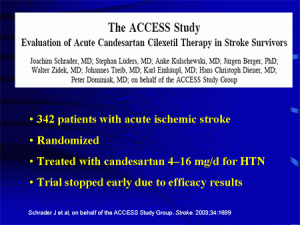Following an acute stroke, it used to be taught in medical school that lowering the blood pressure would be something to avoid for fear that this would lower circulation to the brain and could make a stroke worse. A new study, called ACCESS (Acute Candesartan Cilexitil Therapy in Stroke Survivors), is proving this teaching wrong and demands a 180° turnaround.
Dr. Joachim Schrader has pablished this landmark study recently in the Medical Journal “Stroke” (Stroke – 01-JUL-2003; 34(7): 1699-703). This study followed 339 stroke patients after an initial angiotensin type 1 receptor blocker was given right away versus a control group who got it only 1 week later. In other words, the test here was to see what would happen, if treatment would be started right away during the acute phase of the stroke. Up to now this was only done in the stable period after 1 or 2 weeks (the conventional approach). The 1 year follow-up data showed that the overal death rate from all causes (summing up all complications) was 47.5% less in the treatment group than in the control group. In other words by using intervention with this newer type of blood pressure lowering medication, such as the angiotensin type 1 receptor blocker candesartan (Atacand), complications such as extension of the stroke or heart problems and other complications were averted. The end result were fewer deaths and better quality of life in those who survived.
The Medical Post in its July 29, 2003 edition (p. 1 and 54) interviewed Dr.Ashfak Shuaib, professor of neurology of the University of Alberta in Edmonton, regarding the significance of this study. He felt that there likely would be a new hormonal effect on the brain from the lining of the arteries in the brain that gets blocked and that leads to an increase of blood supply to the brain.
This in turn would rescue the brain tissue around the stroke preventing the late complications. He said that this line of research would be very solid data, but that it would have to be confirmed by an independent study from other investigators. Dr. Shuaib’s group of researchers are planning an imaging study where they will study the blood flow following strokes under the same conditions using candesartan (Atacand).
Link to a chapter on stroke of the Net Health Book.
Last edited October 26, 2014






